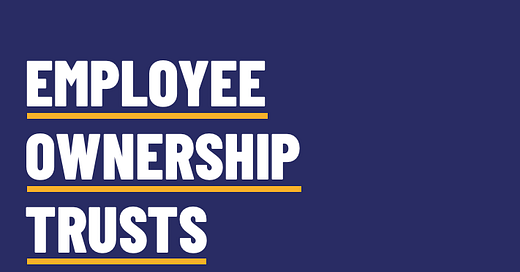Employee Ownership Trusts: In search of best practice
A new report from Ownership at Work in the UK
In brief: In 2022 Ownership at Work, a research partner of the UK-based Employee Ownership Association (EOA), released a survey-based report of employee ownership trusts (EOTs) in the UK. It has lessons for EOTs in other countries, too.
Background: In 2014, the UK government changed policy to incentivize employee ownership through the use of non-charitable purpose trusts. Now there are something like 1400 of them and counting, according to recent statistics from the EOA. Two academics—Andrew Pendleton and Andrew Robinson—have conducted survey research on those EOTs. This week I learned that Ownership at Work had, too.
The findings: You can read the full report here. But for our fast-action readers, here are there findings on how EOTs are operated in practice:
The most common level of equity transferred [to the trust] was either 100% or 51%, with the average being 76%.
Of the various options available to fund a purchase of shares by the trust, the most common method was through a combination of drawing from existing cash in the business and a vendor loan. External financing was the least common route.
The COVID-19 pandemic highlighted the flexibility of vendor loans, and a small number of companies took advantage of this to reduce payments over this period and maintain cashflow.
Most respondents had three to four years left before their loans will be fully repaid, indicating five years as the commpn full term.
Founders mostly retain some form of active role in the company on transition.
Most also tend to feel more comfortable staying closer to the high-level decisions while there was still a significant proportion of the deferred consideration payable.
Although most founders saw their medium to longer term future only as a trustee, few take this step immediately on transition.
More prevalent is a middle phase where the founder reduces to part-time hours as a director whilst a new CEO/MD steps up.
Most companies intend to involve their trustees in the recruitment and appointment of directors to the board of the operating company.
Most companies have a formal schedule of matters that must be referred to the trustees, but the authority of the trust was often less explicit; whether approval or consultation was required.
Trustees were commonly involved in EOT bonus distributions; the process was generally not laid down formally but tended to require approval.
All respondents had a combination of founder, director/management, and employee members, and in most cases also an independent trustee on the trust board.
Most trusts worked to a majority decision, with the chair having a casting vote, but there were examples where unanimous decision was the rule.




